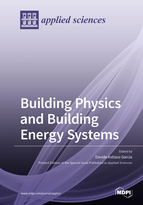Building Physics and Building Energy Systems
A special issue of Applied Sciences (ISSN 2076-3417). This special issue belongs to the section "Energy Science and Technology".
Deadline for manuscript submissions: closed (31 December 2020) | Viewed by 41653
Special Issue Editor
Interests: sustainable energy policies; renewable energy systems; fuels; energy environment assessments
Special Issues, Collections and Topics in MDPI journals
Special Issue Information
Dear Colleagues,
Building physics and building energy systems are based on applied physics applications in civil, architectural, and environmental engineering, including technical themes related to the planning of energy and the environment, diagnostic methods and mitigating techniques, and lighting and acoustics.
This Special Issue aims to provide the state-of-the-art on experimental studies in buildings energy analysis, environmental thermo-fluid dynamics, natural and artificial lighting, environmental and building acoustics, problems in environmental comfort and the conservation of cultural assets, confined environments, the recording and processing of environmental data, and active and passive strategies for environmental monitoring and air-conditioning systems.
For all the aforementioned reasons, we encourage researchers to share their original work on the field of building physics and building energy systems. Topics of primary interest include but are not limited to the following:
- Rational use of energy;
- Use of renewable energy sources;
- Heat transmission;
- Heating and cooling systems
- Thermo-fluid dynamics;
- Lighting;
- Acoustics;
- Energy service management in buildings and urban landscapes;
- Best practices and case studies.
Prof. Davide Astiaso Garcia
Guest Editor
Manuscript Submission Information
Manuscripts should be submitted online at www.mdpi.com by registering and logging in to this website. Once you are registered, click here to go to the submission form. Manuscripts can be submitted until the deadline. All submissions that pass pre-check are peer-reviewed. Accepted papers will be published continuously in the journal (as soon as accepted) and will be listed together on the special issue website. Research articles, review articles as well as short communications are invited. For planned papers, a title and short abstract (about 100 words) can be sent to the Editorial Office for announcement on this website.
Submitted manuscripts should not have been published previously, nor be under consideration for publication elsewhere (except conference proceedings papers). All manuscripts are thoroughly refereed through a single-blind peer-review process. A guide for authors and other relevant information for submission of manuscripts is available on the Instructions for Authors page. Applied Sciences is an international peer-reviewed open access semimonthly journal published by MDPI.
Please visit the Instructions for Authors page before submitting a manuscript. The Article Processing Charge (APC) for publication in this open access journal is 2400 CHF (Swiss Francs). Submitted papers should be well formatted and use good English. Authors may use MDPI's English editing service prior to publication or during author revisions.
Keywords
- Renewable energy production;
- Energy efficiency;
- Heating and cooling;
- Retrofitting;
- Indoor air quality;
- Smart energy systems;
- Lighting;
- Acoustics;
- NZEB (near-zero energy buildings).






